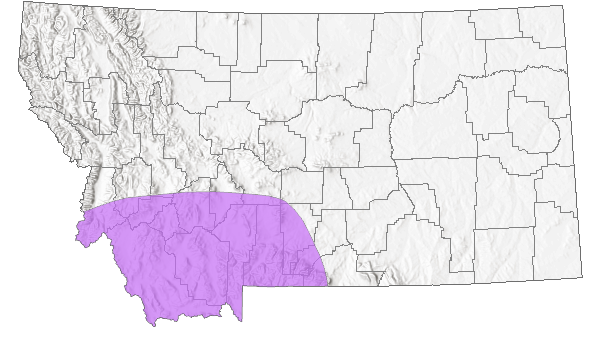View in other NatureServe Network Field Guides
NatureServe
Montana
Utah
Wyoming
Idaho
Wisconsin
British Columbia
South Carolina
Yukon
California
New York
Nevada Sage Grasshopper - Melanoplus rugglesi
General Description
The following is taken from Vickery and Kevan (1985), Pfadt (2002), Capinera et al. (2004), and Scott (2010). The Nevada Sage Grasshopper has two adult phases, migratory and solitary. The migratory phase is a medium sized grasshopper, generally reddish brown with contrasting blackish and pale markings. The solitary phase is often smaller and more grayish in body color, with yellow and reddish tinges on the pronotum and hind femur. The inner face of the hind femur in both phases is bright orange, as are the lower margin of the outer face, but less brilliant in the solitary phase. The hind femur outer face is tan or gray with three transverse black bars. The middle bar is chevron shaped. The hind tibia is blue to purplish.
Phenology
The Nevada Sage Grasshopper is an early season species, hatching in April to May. Adults appear from mid-May or early June and generally disappear by early September (Vickery and Kevan 1985, and Pfadt 2002).
Diagnostic Characteristics
The following comes from Vickery and Kevan (1985), Pfadt (2002), Capinera et al. (2004), and Scott (2010). The body length to end of forewings is 18 to 21 mm for males and 23 to 29 mm for females. The wings (tegmina) of the migratory phase are long and extend beyond the abdomen tip. For the solitary phase, the wings extend to the tip in males and shorter than the tip in females. The shape of the male genital cercus is diagnostic.
The Nevada Sage Grasshopper can be confused with the
Occidental Grasshopper, (
M. occidentalis). Examine the cercus of the male genitalia, which does not taper to a point at the tip, as it does with
M. occidentalis (Vickery and Kevan 1985, and Pfadt 2002).
Species Range
Montana Range
Range Descriptions

 Native
Native
Range Comments
The Nevada Sage Grasshopper is distributed mainly in Nevada and Utah, extending northward into Idaho, eastern Oregon, Washington, western Montana, and southern British Columbia. In Montana, it has been found in two southwest counties (Vickery and Kevan 1985, and Scott 2010).
Habitat
Preferred habitats are in cold desert areas where a diversity of shrubs dominates the vegetation and several sub-dominant forbs and grasses grow in the understory (Vickery and Kevan 1985, Pfadt 2002).
Food Habits
The following is taken from Vickery and Kevan (1985), and Pfadt (2002). This species is primarily a shrub feeder, consuming a variety of sagebrush (
Artemisia) species as well as rabbitbrush,
spiny hopsage, (
Grayia spinosa), bitterbrush, and horsebrush. Among the grasses and forbs, it feeds on
scarlet globemallow, (
Sphaeralcea coccinea), dandelion, and
cheatgrass, (
Bromus tectorum). Studies indicate that the Nevada Sage Grasshopper feeds much less on grasses than on shrubs and forbs.
Reproductive Characteristics
This species overwinters in the egg stage. Upon hatching it passes through 5 instars before reaching the adult stage in about six weeks. Eggs are laid in the ground and each pod consists of 14 to 25 eggs (Vickery and Kevan 1985, and Pfadt 2002).
Management
The following is from Vickery and Kevan (1985) and Pfadt (2002). When this species is abundant in the migratory swarming phase, it can be destructive to shrublands and garden vegetable crops. It is not usually, however, considered a serious pest of rangelands except under periods of drought. Past observations indicate that migration flights are somewhat aimless and that temperature, sunlight, and especially wind influence the swarm’s direction of flight. Favorable flight conditions include a clear sky, combined minimum air temperature of 70 degrees F, soil temperature of 85 degrees F, and wind movement of 2 mph. Moderate to strong winds of about 15 mph cause swarms to become grounded. Swarms of adults have been observed to travel 2 to 4 miles in a day and from 40 to 75 miles over the season. Nymphs have also been observed to make migratory swarm movements over the ground. In one study, Instar stages I to III tended to move erratically and independent of each other. Older Instar stages IV to V moved as orderly bands, some travelling 200 yards in a day and half-a-mile in two weeks.
Stewardship Responsibility
References
- Literature Cited AboveLegend:
 View Online Publication
View Online Publication Capinera, J.L., R.D. Scott, and T.J. Walker. 2004. Field Guide to Grasshoppers, Katydids, and Crickets of the United States. Ithaca, NY. Cornell University Press.
Capinera, J.L., R.D. Scott, and T.J. Walker. 2004. Field Guide to Grasshoppers, Katydids, and Crickets of the United States. Ithaca, NY. Cornell University Press. Pfadt, R.E. 2002. Field Guide to Common Western Grasshoppers, 3rd edition. Laramie, WY: Wyoming Agricultural Experiment Station, Bulletin 912, modified by S. Schell and S. Schell for electronic publication. Accessed 19 February 2020. http://www.uwyo.edu/entomology/grasshoppers/field-guide/index.html#fieldguidetoc
Pfadt, R.E. 2002. Field Guide to Common Western Grasshoppers, 3rd edition. Laramie, WY: Wyoming Agricultural Experiment Station, Bulletin 912, modified by S. Schell and S. Schell for electronic publication. Accessed 19 February 2020. http://www.uwyo.edu/entomology/grasshoppers/field-guide/index.html#fieldguidetoc Scott, R.D. 2010. Montana Grasshoppers, Katydids, and Crickets A Pictorial Field Guide to the Orthoptera. MagpieMTGraphics, Billings, MT.
Scott, R.D. 2010. Montana Grasshoppers, Katydids, and Crickets A Pictorial Field Guide to the Orthoptera. MagpieMTGraphics, Billings, MT. Vickery, V. R. and D. K. M. Kevan. 1985. The grasshopper, crickets, and related insects of Canada and adjacent regions. Biosystematics Research Institute, Ottawa, Ontario. Publication Number 1777. 918 pp.
Vickery, V. R. and D. K. M. Kevan. 1985. The grasshopper, crickets, and related insects of Canada and adjacent regions. Biosystematics Research Institute, Ottawa, Ontario. Publication Number 1777. 918 pp.
- Web Search Engines for Articles on "Nevada Sage Grasshopper"
- Additional Sources of Information Related to "Insects"





